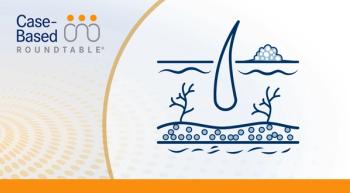
Phase 3 Study Confirms Benefit of Venetoclax/LDAC in Chemotherapy-Ineligible AML
A new randomized placebo-controlled study finds patients with acute myeloid leukemia who cannot undergo intensive chemotherapy have improved outcomes when given venetoclax in addition to low-dose cytarabine.
A new study bolsters the clinical case for using venetoclax (Venclexta) along with low-dose cytarabine (LDAC) in patients with acute myeloid leukemia (AML) who are ineligible for intensive chemotherapy.
The study found venetoclax lowered the risk of death at 12 months by 25% compared with patients given only LDAC (HR, 0.75; 95% CI, 0.52-1.07; P = .11). The drug was also considered to have a manageable safety profile, with the most common severe adverse events being febrile neutropenia, neutropenia, and thrombocytopenia. The study was published in the journal
Andrew H. Wei, PhD, of the Alfred Hospital and Monash University, both in Australia, said the phase 3 trial was designed to focus specifically on the patients with the fewest options—those who, for a variety of reasons, were poor candidates for intensive chemotherapy. Among those reasons is the typical age of a patient diagnosed with AML (average, 68 years). Other barriers to intensive chemotherapy are major organ impairment or ECOG performance scores.
Wei said a previous phase 1b/2 study2 showed strong results in favor of including venetoclax with LDAC, but it also came under criticism for including patients over the age of 75 who had ECOG scores of 0 and 1, who might have been candidates for intensive chemotherapy.
Against that backdrop, Wei said, the authors designed this phase 3 study with more stringent requirements, including ECOG scores of 2 or 3. Interest in the study was high, Wei said.
“The strong desire from clinicians to enroll patients to the venetoclax arm led to a placebo-controlled study design, with a 2:1 allocation to venetoclax versus placebo,” he told Targeted Oncology.
In total, 211 patients were enrolled in the study, with 143 receiving venetoclax in addition to LDAC, and the remaining 68 receiving placebo. Venetoclax/placebo was administered in 28-day cycles, with LDAC administered on days 1 to 10.1
The median age of the enrollees was 76 years old. More than one-third (38%) had secondary AML, and 1 in 5 had previously received treatment with a hypomethylating agent, which has been linked with a poor risk profile, Wei said.
The primary end point was overall survival (OS). At 12 months, the median OS was 7.2 months in the venetoclax arm and 4.1 months in the placebo arm.
However, Wei said investigators decided to do an additional follow-up 6 months later.
“At the time of the event-driven primary analysis, a large number of patients in the LDAC plus venetoclax arm were censored with <6 months of follow-up time,” he said. “In addition, few patients analyzed had >12 months of follow-up.”
The unplanned analysis at 6 months showed a larger OS advantage for patients receiving venetoclax, 8.4 versus 4.1 months (HR, 0.70; 95% CI, 0.50-0.98; P = .04).
Wei said additional findings from the study also support the use of venetoclax. For instance, 22% of patients in the venetoclax arm were salvaged with intensive chemotherapy versus just 8% in the placebo arm. Further, nearly half of the patients receiving venetoclax (48%) had an objective response (complete remission or complete remission with incomplete blood count recovery) versus just 13% of patients in the placebo arm.
“The anti-leukemic benefits of venetoclax translated into longer event-free survival, higher rates of transfusion independence, and improved patient-reported outcomes (PROs) compared with placebo,” Wei said.
In terms of clinical implications, Wei said he expects these findings will have a significant impact on the way physicians treat this subgroup of patients with AML.
“With a dearth of alternative treatment options in elderly AML, it is likely that physicians will be attracted to the patient-oriented benefits of higher response rates, lower transfusion requirements and improved PROs,” he said, adding that the only other approved therapy for these patients that is backed by randomized clinical trial data3 is glasdegib (Daurismo), and glasdegib plus LDAC had a lower overall response rate.
Wei cautioned that these patients will require careful management given the potential for adverse events, though he said physicians experienced with the drug will be well-versed in providing such patient management. Even though these patients face stiff odds, Wei said the present study offers a meaningful ray of hope: “Although there is still a long way to go and there is much to learn, at least the future is brighter than it has ever been for this historically forlorn AML population.”
References:
1. Wei AH, Montesinos P, Ivanov V, et al. Venetoclax plus LDAC for newly diagnosed AML ineligible for intensive chemotherapy: a phase 3 randomized placebo-controlled trial. Blood. 2020;135(24):2137-2145. doi:10.1182/blood.2020004856
2. Wei AH, Strickland SA Jr, Hou JZ, et al. Venetoclax Combined With Low-Dose Cytarabine for Previously Untreated Patients With Acute Myeloid Leukemia: Results From a Phase Ib/II Study. J Clin Oncol. 2019;37(15):1277-1284. doi:10.1200/JCO.18.01600
3. Cortes JE, Douglas Smith B, Wang ES, et al. Glasdegib in combination with cytarabine and daunorubicin in patients with AML or high-risk MDS: Phase 2 study results. Am J Hematol. 2018;93(11):1301-1310. doi:10.1002/ajh.25238















































